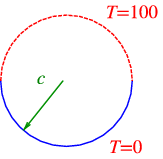
Consider a circular plate of radius c\text{ m}, insulated from above and below. The temperature on the circumference is 10{0}^{∘}\ \text{C} on half the circle, and {0}^{∘}\ \text{C} on the other half.
The differential equation to solve is
|
{ρ}^{2}{{∂}^{2}u\over
∂{ρ}^{2}} + ρ{∂u\over
∂ρ} + {{∂}^{2}u\over
∂{ϕ}^{2}} = 0,
| (8.1) |
with boundary conditions
|
u(c,ϕ) = \left \{\array{
100\quad &\text{if $0 < ϕ < π$}\cr
0 \quad &\text{if $π < ϕ < 2π$} } \right .\quad .
| (8.2) |
There is no real boundary in the ϕ direction, but we introduce one, since we choose to let ϕ run from 0 to 2π only. So what kind of boundary conditions do we apply? We would like to see “seamless behaviour”, which specifies the periodicity of the solution in ϕ,
If we choose to put the seem at ϕ = −π we have the periodic boundary conditions
We separate variables, and take, as usual
|
u(ρ,ϕ) = R(ρ)Φ(ϕ).
| (8.7) |
This gives the usual differential equations
Our periodic boundary conditions gives a condition on Φ,
|
Φ(0) = Φ(2π),\kern 2.77695pt \kern 2.77695pt Φ'(0) = Φ'(2π).
| (8.10) |
The other boundary condition involves both R and Φ.